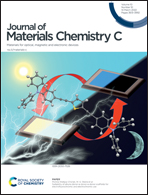Efficient semi-transparent organic solar cells enabled by a quasi-heterojunction active layer structure†
Abstract
Sequentially deposited (SD) donor/acceptor quasi-heterojunctions allow for more freedom to modulate the optical and charge transport properties of the active layer compared to donor:acceptor blend bulk heterojunctions (BHJs). It is expected that the former have potential application in semi-transparent organic solar cells (ST-OSCs). Herein, a comparison study on SD-type and BHJ-type ST-OSCs employing PTB7-Th as the donor and IEICO-4Cl as the acceptor indicates that the SD-type ST-OSCs could improve light utilization efficiencies (LUEs) as compared to BHJ-type ST-OSCs. A wide-bandgap polymer PCDTBT is introduced into the PTB7-Th layer as the second donor in a SD-type device. By doing so, the mixed donor layer not only becomes more robust to the sequential solution processing, but also favors the formation of a quasi-heterojunction with better charge generation and charge collection. Finally, the transparency of the ST-OSCs is further enhanced by introducing a thin MgF2 as the light out-coupling layer atop the semitransparent Au electrode. The optimized ST-OSC achieves a power conversion efficiency of 6.30% with an average visible transmittance of 43.93% and a light utilization efficiency of 2.77%.



 Please wait while we load your content...
Please wait while we load your content...